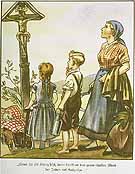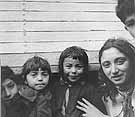
|
|
|

|

|

|

|
|
Click on an image to see a larger, more detailed picture.
|
|
|
|
|
| 1934: Triumph of the Will |

|
pg. 77 |

|
|
|
|
| |
 In 1928 the Nazis publicly made known their opposition to the repeal of Paragraph 175, which stipulated imprisonment for same-gender sexual activity. Once Hitler became chancellor, the government moved quickly against gays, forbidding the mention of homosexuality in magazines and closing gay bars. The Eldorado, a popular gay gathering spot in Berlin, was closed in early March 1934. Accusations of homosexuality resulted in imprisonment in concentration camps, where gays were particularly abused.
In 1928 the Nazis publicly made known their opposition to the repeal of Paragraph 175, which stipulated imprisonment for same-gender sexual activity. Once Hitler became chancellor, the government moved quickly against gays, forbidding the mention of homosexuality in magazines and closing gay bars. The Eldorado, a popular gay gathering spot in Berlin, was closed in early March 1934. Accusations of homosexuality resulted in imprisonment in concentration camps, where gays were particularly abused.
Photo: Landesbildstelle, Berlin/United States Holocaust Memorial Museum Photo Archive
|
 Der Giftpilz (The Poisonous Mushroom) was one of the many antisemitic books written for German children. Highlighting the medieval theme of Jews as Christ-killers, it urges children: ņWhen you see a cross, then think of the horrible murder by the Jews on Golgatha.ņ
Der Giftpilz (The Poisonous Mushroom) was one of the many antisemitic books written for German children. Highlighting the medieval theme of Jews as Christ-killers, it urges children: ņWhen you see a cross, then think of the horrible murder by the Jews on Golgatha.ņ
Photo: United States Holocaust Memorial Museum Photo Archive
|
 Sinti and Roma
Sinti and Roma
Ever since their arrival in Central Europe in the 1400s, the Gypsies had been social outcasts. In the 1930s, when Heinrich Himmler vowed to rid Germany of "asocials," Gypsies were among the targeted groups. Consisting of different "tribes" or "nations," these ethnic minorities were called "Gypsies" because they were thought to have Egyptian origins. The Sinti and Roma tribes were the most common in Germany and Austria, respectively. Labeled by the Nazis as racial "inferiors," Sinti and Roma were regarded as so "unfit" that Himmler's circular of December 8, 1938, "Combating the Gypsy Nuisance," recommended "the final solution of the Gypsy question." Throughout Nazi-occupied Europe, tens of thousands of Gypsies were hunted down and shot or deported and killed in camps. At least 23,000 Roma and Sinti were sent to Auschwitz-Birkenau. During one night alone--August 2-3, 1944--2897 men, women, and children were gassed there during the liquidation of the "Gypsy family camp." The Nazis and their collaborators killed between 20 and 50 percent--220,000 to 500,000--of the Sinti and Roma, who call this genocide the porraimos, or "great devouring," of their people.
|
|

|

|

|

|
 1934: Dorothy Thompson, an anti-Nazi American journalist whose 1932 book I Saw Hitler is critical of the Führer, is expelled from Germany.
1934: Dorothy Thompson, an anti-Nazi American journalist whose 1932 book I Saw Hitler is critical of the Führer, is expelled from Germany.
|
 1934: Restoration work begins at Wewelsburg, a 17th-century cliff-top fortress in Westphalia, Germany. When complete, the castle will be used by Heinrich Himmler and the Schutzstaffel (SS) as a mystical fortress, complete with a 12,000-volume Aryan library and a center for racial research.
1934: Restoration work begins at Wewelsburg, a 17th-century cliff-top fortress in Westphalia, Germany. When complete, the castle will be used by Heinrich Himmler and the Schutzstaffel (SS) as a mystical fortress, complete with a 12,000-volume Aryan library and a center for racial research.
|
 1934: In the United States, the American Christian Defenders (the World Alliance Against Jewish Aggressiveness) is founded by antisemitic propagandist Eugene N. Sanctuary.
1934: In the United States, the American Christian Defenders (the World Alliance Against Jewish Aggressiveness) is founded by antisemitic propagandist Eugene N. Sanctuary.
|
 Early 1934: Hitler Youth members are turned loose throughout Germany to intimidate members of Catholic youth groups.
Early 1934: Hitler Youth members are turned loose throughout Germany to intimidate members of Catholic youth groups.
|
 January 1, 1934: The Nazis remove Jewish holidays from the official German calendar.
January 1, 1934: The Nazis remove Jewish holidays from the official German calendar.
|
 January 1, 1934: German laws allowing sterilization of the "unfit," which were passed in July 1933, are promulgated. Hitler orders the German government to undertake a building program that will produce 4000 aircraft by October 1935.
January 1, 1934: German laws allowing sterilization of the "unfit," which were passed in July 1933, are promulgated. Hitler orders the German government to undertake a building program that will produce 4000 aircraft by October 1935.
|
|
|
|
|
| 1934: Triumph of the Will |

|
pg. 77 |

|
|
The Holocaust Chronicle
© 2009 Publications International, Ltd.
|
|
